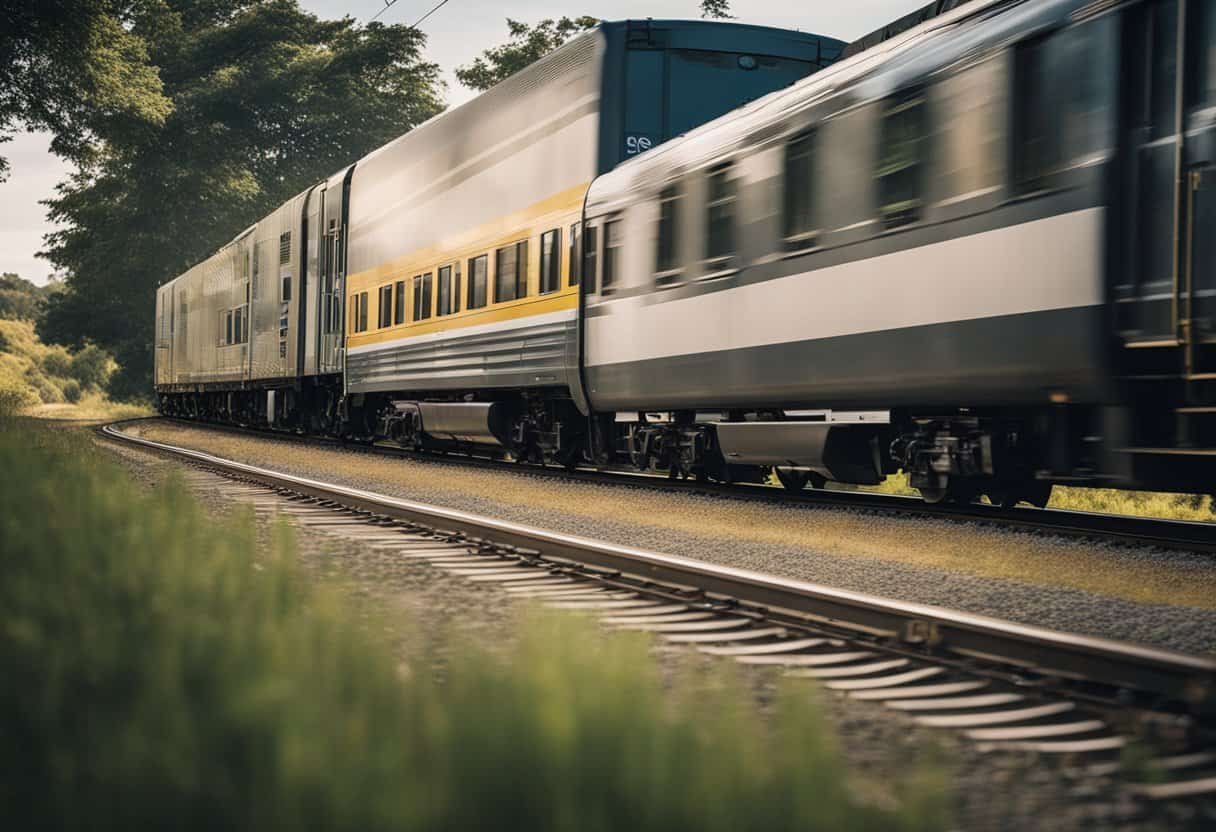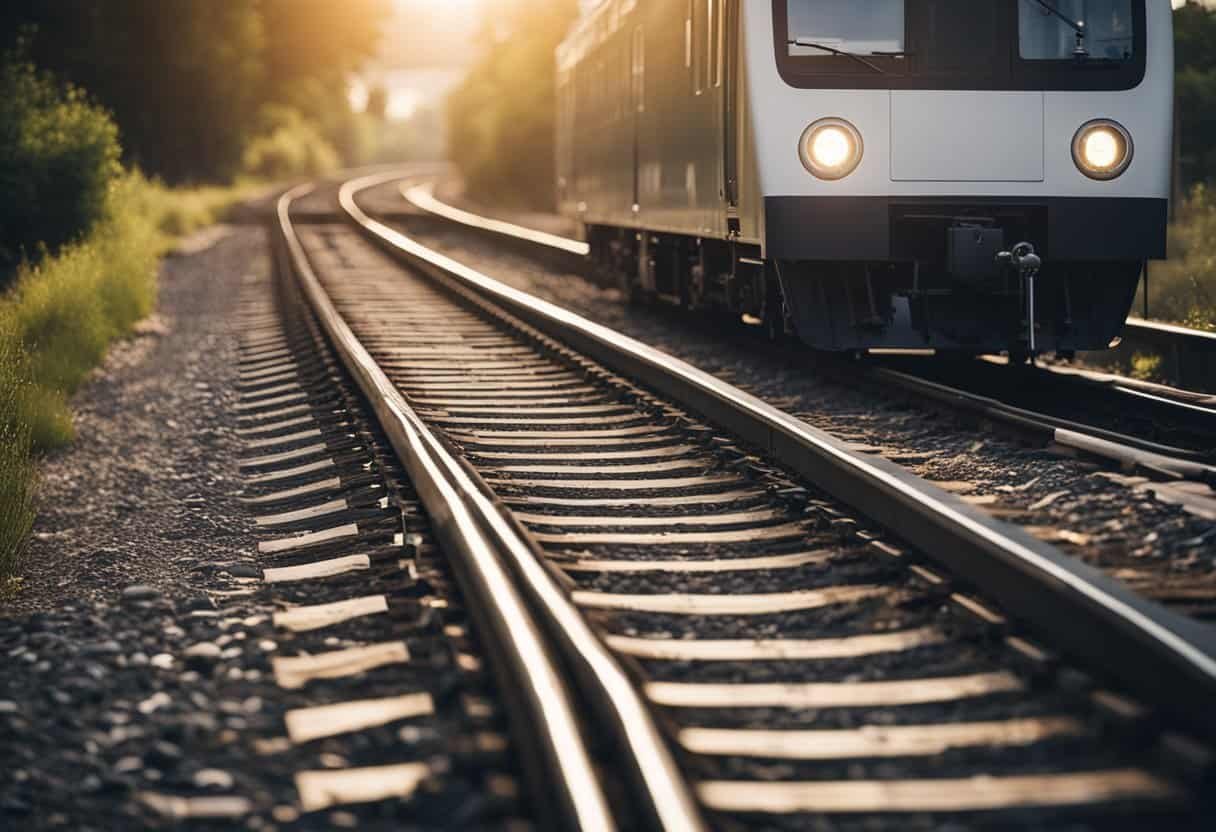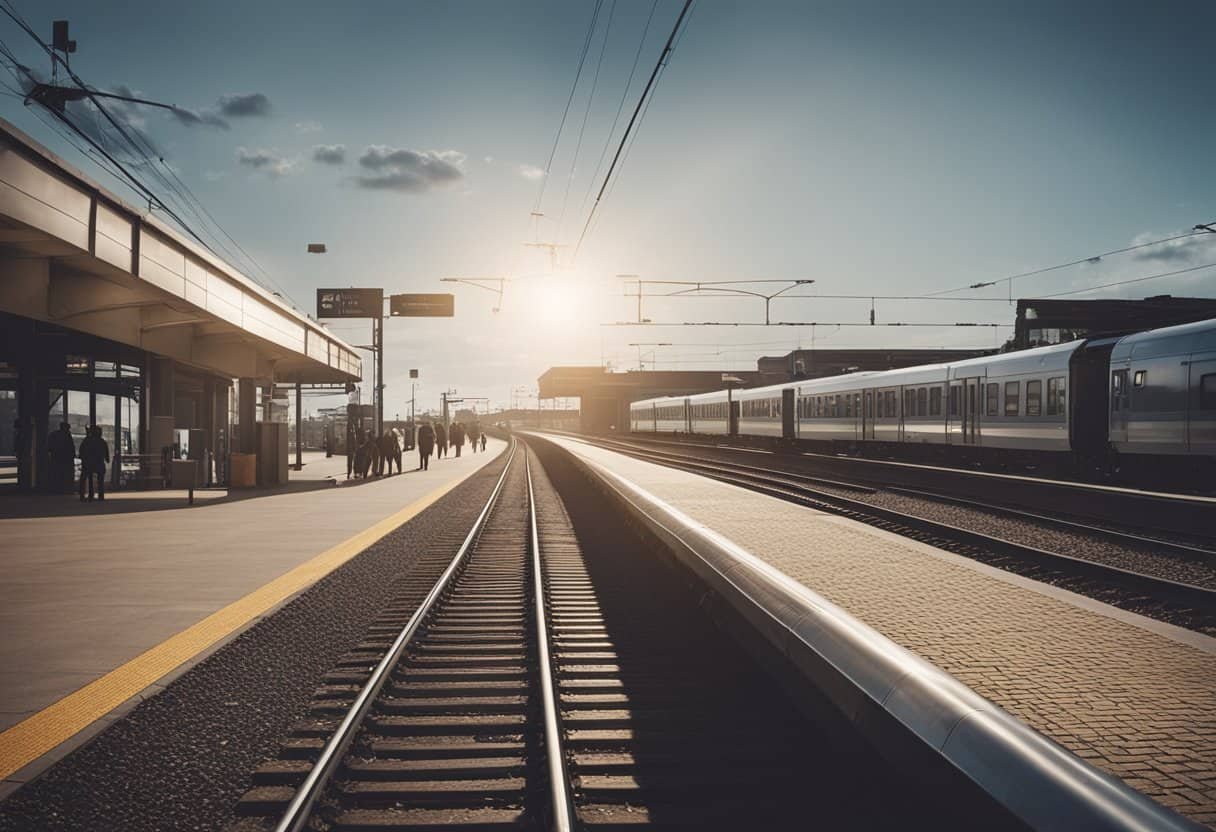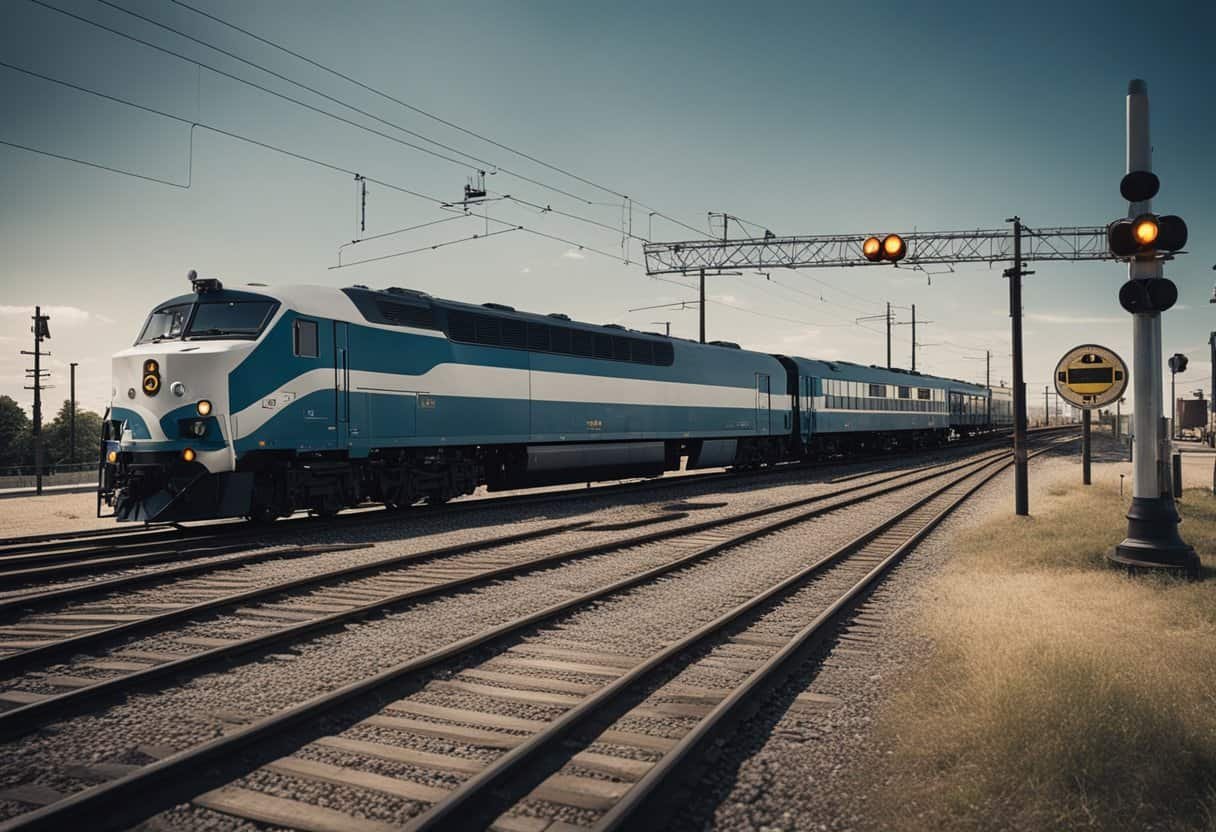If you’ve ever taken a train, you may have noticed that it seems to take much longer to get to your destination than if you were driving a car. This begs the question: why are trains slower than cars? The answer to this question is multifaceted, and involves factors such as infrastructure, technology, geography, and more.

To understand why trains are slower than cars, it’s important to first understand how train and car speeds are measured. Trains are typically measured in miles per hour (mph), while cars are measured in miles per gallon (mpg) or miles per hour (mph). While trains may have the capacity to travel at much higher speeds than cars, they are often limited by factors such as track conditions, curves, and inclines, which can slow them down considerably.
When comparing trains and cars, it’s important to consider the role of infrastructure in determining their respective speeds. Trains require specialized tracks and infrastructure in order to travel efficiently, while cars can travel on a variety of surfaces, including highways, city streets, and dirt roads. Additionally, trains are often subject to delays and other issues due to the need to share tracks with other trains, while cars can travel freely without being restricted by other vehicles.
Key Takeaways
- Train speeds are typically measured in mph, while car speeds are measured in mpg or mph.
- Infrastructure plays a significant role in determining the speed of trains and cars.
- Trains are often subject to delays and other issues due to the need to share tracks with other trains.
Understanding Train and Car Speeds
Concept of Speed
Speed is the measure of how fast an object is moving. It is calculated by dividing the distance traveled by the time taken to travel that distance. In the context of trains and cars, speed is an important factor in determining how quickly you can get from one place to another.
Trains and cars both have different maximum speeds. The maximum speed of a train is determined by the power of its locomotives and the condition of its tracks. On the other hand, the maximum speed of a car is determined by the power of its engine and the condition of its tires.
Factors Affecting Speed
There are several factors that affect the speed of trains and cars. Let’s take a closer look at some of these factors:
Distance
The distance between two points can have a significant impact on the speed of a train or car. Trains are generally faster than cars over long distances because they can maintain a consistent speed without stopping. Cars, on the other hand, have to stop and start at traffic lights, stop signs, and other obstacles, which can slow them down.
Power
The power of a train or car’s engine is another important factor that affects its speed. Trains have powerful locomotives that can pull heavy loads at high speeds. Cars, on the other hand, have smaller engines that are designed for speed and agility rather than raw power.
Faster vs. Slower
When it comes to speed, trains are generally slower than cars over short distances. This is because trains take longer to accelerate and decelerate than cars. However, over long distances, trains can be faster than cars because they can maintain a consistent speed without stopping.
In conclusion, the speed of a train or car is affected by several factors, including distance, power, and acceleration. While trains are generally slower than cars over short distances, they can be faster over long distances because they can maintain a consistent speed without stopping.
Comparison Between Trains and Cars
When it comes to transportation, trains and cars are two of the most commonly used modes. However, they differ in several aspects, including speed, distance, and efficiency. In this section, we will compare trains and cars and explore why trains are generally slower than cars.
Speed
Cars are generally faster than trains. According to an article from Vehicle Help, cars can typically travel at speeds of up to 65 miles per hour (mph), while trains usually travel at speeds of around 50 mph. However, there are some exceptions to this rule. For example, some high-speed trains can travel at speeds of up to 200 mph.
Distance
Trains are designed for long-distance travel, while cars are better suited for short trips. Trains can travel hundreds of miles without stopping, while cars need to be refueled every few hundred miles. This is because trains have larger fuel tanks and are more fuel-efficient than cars. According to an article from The Conversation, freight railroads can move a ton of cargo for around 479 miles on a gallon of fuel, which is about 11 times more energy-efficient than trucks.
Efficiency
Trains are more efficient than cars when it comes to transporting large amounts of cargo or passengers. According to an article from Nature, using public transportation takes on average 1.4-2.6 times longer than driving a car, but it is more efficient in terms of energy use and emissions. Trains can transport hundreds of passengers and tons of cargo at once, while cars can only transport a few passengers and a limited amount of cargo.
In conclusion, while trains are generally slower than cars, they are more efficient and better suited for long-distance travel. Cars are better suited for short trips and are generally faster than trains.
Role of Infrastructure
Infrastructure plays a crucial role in determining the speed of trains and cars. Without efficient infrastructure, both modes of transportation cannot reach their full potential. In this section, we will discuss the role of infrastructure in train and car transportation.
Train Infrastructure
Train infrastructure is composed of tracks, signals, and other systems that allow trains to move from one place to another. The quality of tracks and the signaling system can significantly impact the speed of trains. In many cases, trains have to slow down due to poor track conditions or outdated signaling systems.
In addition to tracks and signals, other factors such as the weight of the train, the curvature of the tracks, and the gradient of the terrain can also impact the speed of trains. For example, a train traveling uphill will move slower than a train traveling on a flat surface.
Car Infrastructure
Car infrastructure includes roads, bridges, and tunnels that allow cars to move from one place to another. The quality of roads and highways can significantly impact the speed of cars. The Interstate Highway System, for example, has significantly improved the speed of cars in the United States.
In addition to roads and highways, other factors such as traffic congestion, road construction, and weather conditions can also impact the speed of cars. For example, during rush hour, cars have to slow down due to traffic congestion.
In conclusion, the quality of infrastructure plays a significant role in determining the speed of trains and cars. While both modes of transportation have their own unique infrastructure needs, it is essential to invest in high-quality infrastructure to improve the speed and efficiency of both trains and cars.
Technological Influence

Trains have been around for centuries, and over time, they have undergone significant technological advancements that have improved their speed, safety, and efficiency. However, despite these advancements, trains are still slower than cars. Let’s take a closer look at the technological influence on train speed.
One of the most significant factors that affect train speed is the infrastructure. Trains require a dedicated track to travel on, and this track must be built to specific standards. The track must be level, straight, and wide enough to accommodate the train’s size. Additionally, the track must be maintained regularly to ensure that it remains in good condition.
Another factor that affects train speed is the type of train being used. High-speed trains, such as the Alstom TGV, are designed to travel at speeds of up to 200 mph. These trains use advanced technology, such as aerodynamic designs and powerful engines, to achieve these speeds. However, these trains are expensive to build and maintain, and they require specialized infrastructure.
Tilting trains are another type of train that can achieve higher speeds. These trains use a tilting system that allows them to lean into curves, reducing the centrifugal force that would otherwise slow them down. China has been at the forefront of developing tilting trains, with their CRH380A train achieving speeds of up to 236 mph.
Despite these advancements, trains are still slower than cars. One reason for this is that trains have to make frequent stops, while cars can travel directly from point A to point B. Additionally, trains have to share the track with other trains, which can cause delays.
In conclusion, technological advancements have had a significant influence on train speed. However, despite these advancements, trains are still slower than cars. The infrastructure, type of train, and frequency of stops all play a role in determining train speed.
Geographical Impact

Geography plays a significant role in determining the speed of trains. The terrain and landscape of a region can affect the speed at which trains can travel. For example, in the United States, the Northeast Corridor, which connects major cities like Boston, New York, and Washington D.C., has a lot of curves and tunnels due to the hilly terrain. As a result, trains on this route cannot travel at high speeds, which limits their overall speed.
Similarly, in cities like San Francisco and Seattle, trains have to navigate steep hills and sharp curves, which slows them down. In contrast, cars have more flexibility and can take alternative routes to avoid these obstacles, allowing them to travel at higher speeds.
In Europe and China, where the terrain is generally flatter, trains can travel at higher speeds. For example, in China, the high-speed rail network connects major cities and can travel at speeds of up to 217 mph. In Europe, the Eurostar, which connects London to Paris and Brussels, can travel at speeds of up to 186 mph.
Overall, geography plays a significant role in determining the speed of trains. While trains are slower than cars in some regions due to the terrain, they can travel at high speeds in areas with flatter landscapes.
Environmental Considerations

When it comes to the environment, trains are generally considered a more eco-friendly mode of transportation compared to cars. Trains produce fewer carbon emissions per passenger mile than cars, making them a more sustainable choice. According to the Federal Railroad Administration, rail transportation produces lower greenhouse gas (GHG) emissions than roadway and air transportation. Shifting trips from road and air to rail in markets where it makes sense can reduce overall transportation emissions.
In addition to reducing carbon emissions, trains also have the potential to reduce pollution. When trains are used instead of cars, there are fewer cars on the road, which leads to less pollution and congestion. Trains are also less noisy than cars, which can reduce noise pollution in urban areas.
However, it’s important to note that the environmental benefits of trains can vary depending on a variety of factors. For example, the type of fuel used to power the train can impact its environmental impact. Trains that run on electricity or other renewable energy sources are typically more environmentally friendly than those that run on diesel or other fossil fuels.
It’s also worth noting that while trains may be more eco-friendly than cars, they are not without their environmental impacts. The construction and maintenance of rail infrastructure can have environmental consequences, such as habitat destruction and soil erosion. Additionally, the manufacturing and disposal of trains and train components can also have environmental impacts.
Overall, when it comes to the environment, trains have the potential to be a more sustainable choice compared to cars. However, it’s important to consider a variety of factors when comparing the environmental impact of different modes of transportation.
Economic Factors
When it comes to transportation, economic factors play a significant role in determining the speed of trains compared to cars. Let’s explore some of these factors.
Fuel Efficiency
Trains are more fuel-efficient than cars. They can carry a lot more passengers or cargo per gallon of fuel. However, the initial cost of building and maintaining trains is much higher than cars. This cost is often passed on to the consumer, making train travel more expensive than car travel.
Cost of Diesel
Diesel is the primary fuel used by trains. The cost of diesel can fluctuate, affecting the price of train tickets. When diesel prices are high, train tickets become more expensive. This can result in fewer people using trains and opting for car travel instead.
Cheaper Alternative
Cars are often a cheaper alternative for short distances. For example, if you need to travel a distance of 50 miles, it may be cheaper to drive your car than to take a train. This is because the cost of maintaining a car is significantly lower than that of a train.
Money
The cost of building and maintaining train tracks is expensive. Governments often subsidize train travel to make it more affordable for the public. However, these subsidies can be cut, resulting in higher ticket prices. This can make train travel less attractive to consumers.
In summary, economic factors play a significant role in determining the speed of trains compared to cars. While trains are more fuel-efficient, the initial cost of building and maintaining them is much higher than cars. Additionally, the cost of diesel can fluctuate, affecting the price of train tickets. Cars are often a cheaper alternative for short distances, and the cost of building and maintaining train tracks is expensive.
Comfort and Convenience

When it comes to comfort and convenience, driving a car is often the preferred option for many people. You have control over the route you take, the speed at which you travel, and the ability to stop whenever you want. This can make for a more comfortable and convenient journey, especially if you are traveling at night or with children.
On the other hand, train travel can offer its own unique comforts. Many trains offer amenities such as Wi-Fi, food and drink services, and comfortable seating. Additionally, you don’t have to worry about navigating traffic or finding a place to park, which can reduce stress and make for a more relaxing journey.
However, it’s important to note that train travel can also have its drawbacks. Trains often have limited seating options, which can make for a less comfortable journey, especially if you are traveling during peak hours. Additionally, train schedules may not always align with your travel plans, which can be inconvenient.
Overall, when it comes to comfort and convenience, the choice between driving a car or taking a train largely depends on your personal preferences and travel needs. While driving may offer more control over your journey, train travel can offer unique amenities and reduce stress.
Safety Measures

Trains are one of the safest modes of transportation, and this is due to the various safety measures that are in place. Here are some of the safety measures that make train travel safe:
Emergency Brake System
Most trains have an emergency brake system that can stop the train within a short distance. This system is activated when the driver or conductor pulls a lever or pushes a button. The emergency brake system is designed to stop the train in case of an emergency, such as a signal failure, a track obstruction, or a passenger falling onto the tracks.
Automatic Train Control
Automatic Train Control (ATC) is a safety system that is used to prevent train collisions. This system uses sensors to detect the position of trains on the tracks and sends signals to the trains to stop or slow down if they are too close to each other. ATC is designed to prevent accidents caused by human error, such as a driver missing a signal or a conductor falling asleep.
Positive Train Control
Positive Train Control (PTC) is a safety system that is used to prevent train derailments and collisions caused by excessive speed. This system uses GPS technology to track the position and speed of trains and sends signals to the trains to slow down or stop if they are going too fast. PTC is designed to prevent accidents caused by human error, such as a driver or conductor speeding or failing to brake in time.
Safety Gates
Safety gates are used to prevent cars and pedestrians from crossing the tracks when a train is approaching. These gates are usually operated automatically and are designed to close when a train is detected. Safety gates are an effective way to prevent accidents caused by cars or pedestrians crossing the tracks when a train is approaching.
In conclusion, trains are one of the safest modes of transportation due to the various safety measures that are in place. Emergency brake systems, automatic train control, positive train control, and safety gates are just a few of the safety measures that make train travel safe.
Future of Train Travel

The future of train travel is promising, with many advancements in technology and infrastructure on the horizon. Progress is being made towards high-speed trains that can travel at speeds of up to 300 miles per hour, which would make train travel much faster than driving. These trains are already in use in countries such as Japan, China, and France, and there is increasing demand for them in other parts of the world.
One of the main benefits of high-speed trains is that they are more energy-efficient than cars, which helps to reduce carbon emissions and combat climate change. In addition, high-speed trains can carry more passengers than cars, which helps to alleviate traffic congestion and reduce the number of accidents on the road.
There is also a growing demand for train travel, as people become more conscious of the environmental impact of driving and flying. Train travel is often seen as a more sustainable and eco-friendly mode of transportation, and many people prefer it for that reason. As a result, there is a need for more investment in train infrastructure to meet this demand.
In the future, we can expect to see more investment in high-speed trains and other forms of sustainable transportation. This will help to reduce our reliance on cars and planes, and create a more sustainable future for all.

